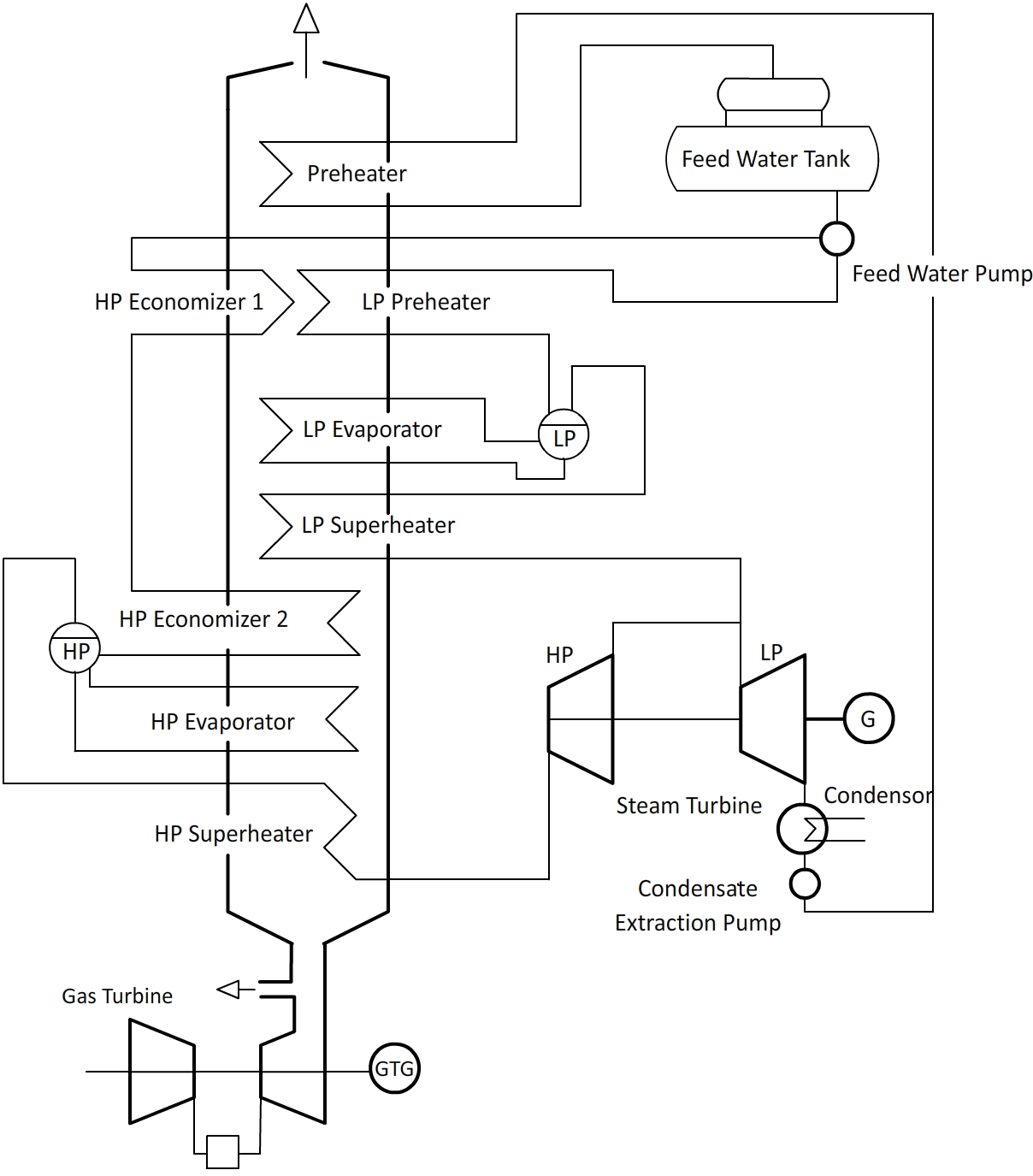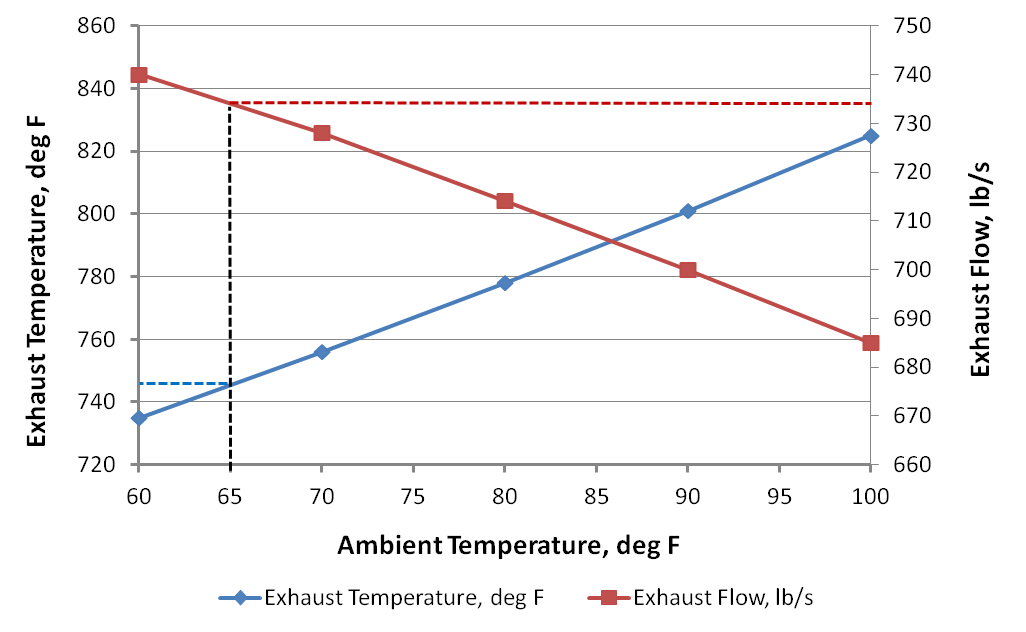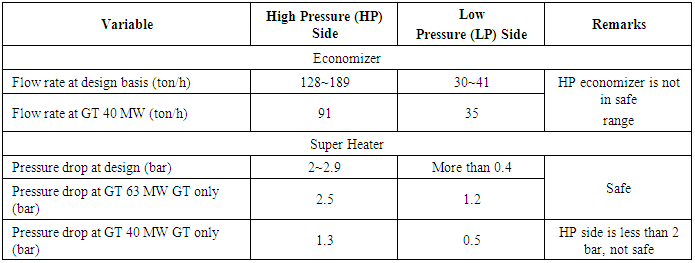-
Paper Information
- Paper Submission
-
Journal Information
- About This Journal
- Editorial Board
- Current Issue
- Archive
- Author Guidelines
- Contact Us
International Journal of Energy Engineering
p-ISSN: 2163-1891 e-ISSN: 2163-1905
2018; 8(4): 89-92
doi:10.5923/j.ijee.20180804.01

Frequency Control Operation of a Combined Cycle Power Plant and Impact on Heat Recovery Steam Generator – A Case Study
U. G. Kithsiri1, N. S. Senanayake2, Ruchira Abeyweera2
1University of Gavle, Sween
2Department of Mechanical Engineering, The Open University of Sri Lanka, Nugegoda, Sri Lanka
Correspondence to: N. S. Senanayake, Department of Mechanical Engineering, The Open University of Sri Lanka, Nugegoda, Sri Lanka.
| Email: |  |
Copyright © 2018 The Author(s). Published by Scientific & Academic Publishing.
This work is licensed under the Creative Commons Attribution International License (CC BY).
http://creativecommons.org/licenses/by/4.0/

Load frequency control is very vital to maintain system stability in power network. In Sri Lanka load frequency control is normally done with the support of hydro power generation units. However, during the periods of drought, gas turbines are heavily used to meet the power demand; hence frequency control has to be done with a gas turbine. Only one combined cycle power plant in Sri Lanka is used to frequency control. As CCGT (Combined Cycle Gas Turbine) is coupled with the steam turbine through a Heat Recovery Steam Generator (HRSG), the level of operation of the gas turbine affects the HRSG because of varying gas turbine exhaust gas temperature and the flow rate. In frequency control mode operation naturally the gas turbine has to be operated in a range of power output responding to power demand. This sets a minimum level of gas turbine power that will not affect the HRSG. This study was carried out to investigate the possibility of using combined cycle power plant (CCPP) for load frequency control without affecting the HRSG. The experimental trials were carried out at 60 MW gas turbine output, it was experimentally proved that the selected CCPP can be operated for frequency control at selected load (60MW). Further, the gas turbine when operated at 40 MW output, the exhaust gas temperature and the flow rate derived from the characteristic relationship of gas turbine were used to predict the critical parameters of the steam cycle. The finding showed that the HRSG parameters are not in safe working ranges. This indicates that the minimum gas turbine output should lie between 40 MW and 60 MW.
Keywords: Frequency Control, HRSG, CCPP
Cite this paper: U. G. Kithsiri, N. S. Senanayake, Ruchira Abeyweera, Frequency Control Operation of a Combined Cycle Power Plant and Impact on Heat Recovery Steam Generator – A Case Study, International Journal of Energy Engineering, Vol. 8 No. 4, 2018, pp. 89-92. doi: 10.5923/j.ijee.20180804.01.
Article Outline
1. Introduction
- Maintaining voltage and frequency within designated limits is an essential requirement for the operation of any power network. The system frequency is determined by the speed of rotation of the generators in the system, which in turn is determined by the balance between generator and load power. During the operating period, the deviations between the actual generation and the actual load are taken care of by frequency control schemes which activate frequency control reserves to maintain the balance between generation and consumption. Frequency control reserves are power reserves kept in participating power plants. Load Frequency Control is badly needed for a power system because, if the normal frequency is 50 Hertz and the system frequency falls below 47.5 Hertz or goes up above 52.5 Hertz then the blades of the turbine are likely to get damaged so as to prevent the stalling of the generator [1].Some frequency control reserves are continuously controlled so as to quickly respond to changes in the system known as primary and secondary frequency control schemes. Some others correspond to discrete actions taken by the system operator who can ask power producers to manually increase or decrease the production levels of some of their power plants called tertiary frequency control schemes. In the last couple of decades, there has been a huge trend in installing gas turbine (GT) based industrial power plants, especially with combined cycle with steam turbine (ST) throughout the world. One of the main reasons was the high overall efficiency. All major GT manufacturing companies, including General Electric, ABB-Alstom, Westinghouse Siemens and Mitsubishi offer CCGT plants of power range 680 MW, with very high efficiency claimed up to 62%. [2]. The other major concern is the unfavourable responses of existing coal based steam cycle thermal power plants resulting in unexpected grid behaviour after major disturbances. In many cases simple cycle gas turbine plants have been installed in the world for spinning reserve requirements, rather than base load requirements. The requirement of fast governor response with appropriate spinning reserve was also reason for installing CCGT plants with powerful gas turbines.Many researchers have focused on performance improvement of CCGT power plant utilizing the Brayton Cycle gas turbine and Rankine Cycle steam turbine with air and water as working fluids [3-5]. However, the possibility of using of CCGT for load frequency control has not been tested and reported.
2. The Case Study - CCPP on Frequency Control
- In the present study, combined cycle Power Plant in Sri Lanka was studied to explore the possibility of using the GT for frequency control. Figure 1 below shows the layout of the Combine Cycle power Plant. It has been designed for a load from 60% to 100% in 2001 during construction. At present the CCPP operates with the following conditions:
 | Figure 1. Layout of Combine Cycle Power Plant |
3. Methodology
- The CCPP was operated with GT power output of 60 MW with total power being 100 MW. Under this operational level, the critical parameters of the HRSG were measured and compared them with recommended values by the manufacturer. The following were the measured parameters for different HRSG components.Economizer: Mass flow rate of waterSuper Heater: Mass flow rate of steam and pressure dropBoiler drum: Wall temperature differenceThe economizer recommended mass flow rates at the design are 128 – 189 ton per hour and 30 – 41 ton per hour for high pressure side and low pressure side respectively. The pressure drop should be in the range 2 – 2.9 bar for high pressure side and more than 0.4 bar for the low pressure side. The maximum differential temperature between inner surface and middle wall of HP (High Pressure) drum is to be 30°C [6].Further, the parameters of HRSG were studied when the GT output is 40 MW. The GT variables (flue gas flow rate and the temperature) were obtained corresponding to the site variables from the GT performance characteristic provided at the design stage. With these input data HRSG variables were determined with the aid of HRSG simulation software.
4. Results
- Comparison of measured variables and safe ranges for the economizer, super heater and the maximum wall temperature difference when the GT output was 62 – 64 MW, are presented in Table 1.
|
 | Figure 2. GT exhaust flow rate and temperature |
|
5. Conclusions
- The frequency control operation from GT 60 MW to GT base load is acceptable because it is within the initial engineering value. For GT 40MW, that is minimum load for GT it is far expose to potential damage on HP economizer due to flow stagnation and HP super heater due to flow unbalance among tubes.The safe partial load is 100 MW (combined cycle mode) which is 60% of designed output of CCPP. Since operating the GT at 40MW was found to be not safe, the actual lowest point should be in between GT load of 40-60 MW.
ACKNOWLEDGEMENTS
- The support extended by the staff of the Power Plant is greatly appreciated.
 Abstract
Abstract Reference
Reference Full-Text PDF
Full-Text PDF Full-text HTML
Full-text HTML
